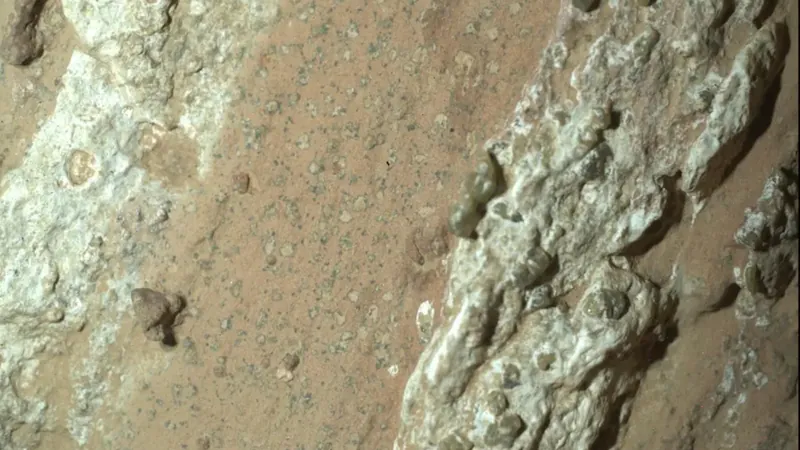
Is Jezero Crater the Key to Unraveling Mars' Mysteries? New Evidence Suggests It Might Have Hosted Life
2025-09-19
Author: Amelia
New Discoveries in Jezero Crater Raise Hopes for Ancient Life
Just a week after NASA's Perseverance rover hinted at a potential biosignature within a Martian rock called Sapphire Canyon, a breakthrough study has emerged that suggests Jezero Crater may have frequently hosted life-friendly conditions. This research expands the hunt for ancient life on the Red Planet.
Unlocking the Secrets of Jezero Crater
In a detailed analysis, scientists uncovered 24 distinct minerals showcasing the evolution of Jezero’s environment, revealing a volcanic history intertwined with significant interactions with water. While the Sapphire Canyon sample wasn't directly assessed, the study underscores the crater’s rich history of water activity, presenting multiple scenarios where conditions could have supported life as we know it.
Eleanor Moreland, the study's lead author from Rice University, emphasizes that several periods in Mars' history allowed volcanic materials in Jezero to interact with liquid water, enhancing prospects for habitability.
A Tale Told by Minerals
The team gathered three years of data from the Perseverance rover, which has been diligently exploring Jezero since 2021. Using advanced X-ray technology and a novel processing algorithm named MIST, researchers crafted a "mineralogical archive" of the crater.
These minerals act as nature’s storytellers, revealing various stages of water-rock interactions with important implications for the possibility of life. The researchers conducted thousands of simulations to refine their conclusions and establish confidence in their findings.
The History of Water in Jezero
The oldest rocks in the crater showcased evidence of corrosive, hot fluids, identified through minerals like greenalite and hisingerite. Although these conditions were hostile to life, study co-author Kirsten Siebach pointed out that, similar to extreme environments on Earth, life can endure in such extremes.
Later water interactions introduced more hospitable minerals, suggesting a shift towards cooler, neutral environments better suited for microbial life.
A Ground-Breaking Look at Mars' Conditions
The study highlights the presence of sepiolite, a mineral that thrives in low-temperature alkaline waters, across various regions explored by Perseverance. This pervasive mineral suggests that Jezero experienced a shift towards conditions that are increasingly favorable for life.
The findings echo previous revelations from Perseverance’s exploration of Cheyava Falls, where conditions indicative of microbial life were uncovered, marking significant progress in our understanding of Mars' capability to host life.
Future Missions: A Race to Bring Mars Back to Earth
As interest in Mars intensifies, follow-up laboratory analyses on Earth will be crucial to determine the biological nature of the rover's findings. NASA’s Perseverance project is eyeing a Mars Sample Return mission, but financial constraints have led to potential re-evaluations of the program's timeline.
Meanwhile, China is forging ahead with its own sample-return mission, aiming to collect Martian materials by 2028, which could place it ahead of NASA in this historic race.
Honing in on the Most Valuable Samples
The newly developed MIST algorithm promises to assist scientists in selecting the most relevant Martian samples to bring back to Earth. By determining the confidence levels of mineral identifications, this tool will be vital in deciding which samples are prioritized for the proposed Mars Sample Return mission.
The insights from this research not only deepen our understanding of Jezero Crater’s environment but also set the stage for future explorations into Mars' tantalizing possibilities for past life.









 Brasil (PT)
Brasil (PT)
 Canada (EN)
Canada (EN)
 Chile (ES)
Chile (ES)
 Česko (CS)
Česko (CS)
 대한민국 (KO)
대한민국 (KO)
 España (ES)
España (ES)
 France (FR)
France (FR)
 Hong Kong (EN)
Hong Kong (EN)
 Italia (IT)
Italia (IT)
 日本 (JA)
日本 (JA)
 Magyarország (HU)
Magyarország (HU)
 Norge (NO)
Norge (NO)
 Polska (PL)
Polska (PL)
 Schweiz (DE)
Schweiz (DE)
 Singapore (EN)
Singapore (EN)
 Sverige (SV)
Sverige (SV)
 Suomi (FI)
Suomi (FI)
 Türkiye (TR)
Türkiye (TR)
 الإمارات العربية المتحدة (AR)
الإمارات العربية المتحدة (AR)